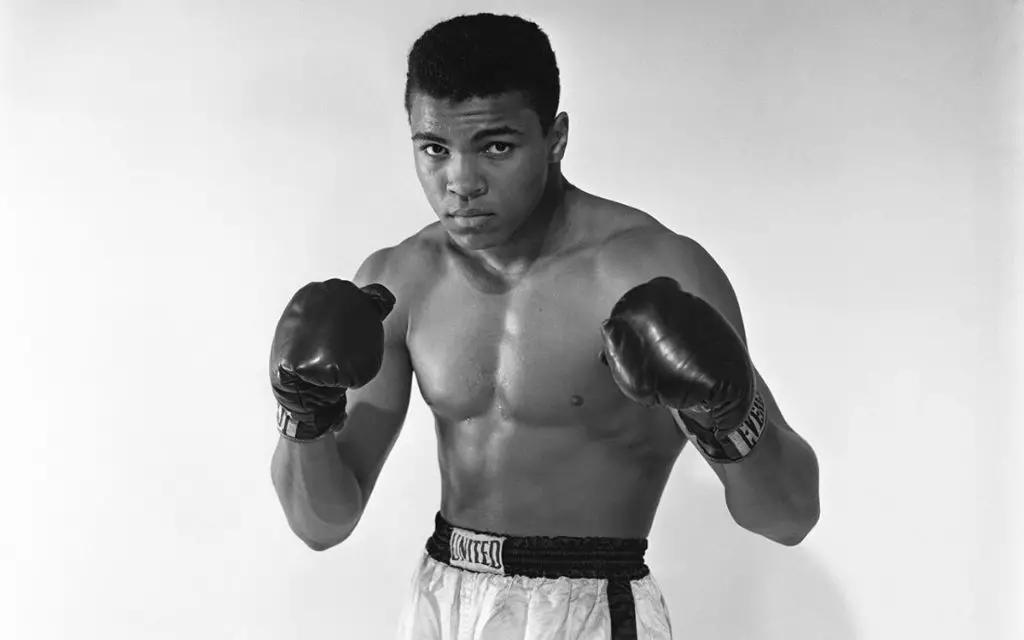What Is The Story Behind Cassius Clay?
Early Life
Cassius Marcellus Clay Jr. was born on January 17, 1942 in Louisville, Kentucky.[1] His father, Cassius Marcellus Clay Sr., was a sign painter and his mother, Odessa Grady Clay, worked as a household domestic.[2] As a young child, Clay was introduced to boxing by a police officer named Joe Martin, who suggested that Clay learn how to box after Clay reported his bike had been stolen.[1] Martin became Clay’s first boxing coach, training him at the Columbia Gym in Louisville.[3] As an amateur boxer, Clay won six Kentucky Golden Gloves titles, two national Golden Gloves titles, and an Amateur Athletic Union national title. He had a record of 100 wins with five losses and had 78 knockouts.[2]
[1] https://en.wikipedia.org/wiki/Muhammad_Ali
[2] https://www.biography.com/athletes/muhammad-ali
[3] https://www.britannica.com/biography/Muhammad-Ali-boxer
Amateur Boxing Career
Muhammad Ali, then known by his birth name Cassius Clay, began boxing at the age of 12. As an amateur boxer, he went on to win the national Golden Gloves tournament twice, in 1959 and 1960. In 1960, at just 18 years old, Clay qualified for the Summer Olympics in Rome. He went on to win the gold medal in the light heavyweight division after defeating Zbigniew Pietrzykowski of Poland in the final.[1][2] His Olympic gold medal was considered a major accomplishment at his young age.
Early Professional Boxing Career
Clay made his professional debut on October 29, 1960, winning a six-round decision over Tunney Hunsaker (Boxing career of Muhammad Ali). From then until the end of 1963, Clay amassed a record of 19-0 with 15 wins by knockout. He defeated boxers including Tony Esperti, Jim Robinson, Donnie Fleeman, Alonzo Johnson, George Logan, Willi Besmanoff, Lamar Clark, Doug Jones and Henry Cooper (Muhammad Ali).
Clay had a flashy, idiosyncratic style that was not typical of boxers of his era. He danced around the ring, shuffled his feet to confuse and tire out opponents, and held his hands unusually low. Despite his unorthodox tactics, he started to rise up the ranks with his quick reflexes and strong punches. Clay often taunted his opponents by predicting the round he would knock them out. He captivated crowds and gained a reputation for being boastful and outspoken.
Joining the Nation of Islam
In the early 1960s, Clay was first introduced to the Nation of Islam by amateur boxer Ronnie King. He began studying the teachings under Nation of Islam minister Malcolm X, who became a close friend and mentor. Malcolm X planted the idea that Clay should dissociate from what Malcolm called his “slave name” and accept a new name given by the Nation.

In February 1964, after defeating Sonny Liston to become heavyweight champion, Clay confirmed publicly that he had converted to Islam and had adopted the name Muhammad Ali. This name change was controversial at the time, with certain sportswriters refusing to use Ali’s new name and instead continuing to refer to him as Cassius Clay.
Ali later elaborated on his decision to join the Nation of Islam in a 1967 interview, saying “I had to undergo many emotional battles within my own mind. Many people who I thought were in my corner were not there. The world’s press was seething and waiting to take a shot. From now on I would be fighting against them too.”
Malcolm X later broke with the Nation of Islam in 1964 and was assassinated in 1965. Despite this tragic loss of a close friend, Ali remained devoted to the Nation of Islam under the leadership of Elijah Muhammad.
World Heavyweight Champion
After defeating Sonny Liston in 1964 to become heavyweight champion, Clay confirmed himself as ‘The Greatest’ by successfully defending his title in rematches against Liston and other top contenders like Floyd Patterson and George Chuvalo. Clay was brash and cocky, often taunting opponents in the ring with his quick footwork and fast hands. His unorthodox style made him difficult to hit cleanly, and he was able to outbox opponents despite not being the biggest or strongest heavyweight. Clay ended up defending his title nine times between 1964 to 1967, beating every challenger who stepped into the ring with him. His quickness, stamina and sheer will to win cemented his status as the undisputed best heavyweight in the world.
Vietnam War and Draft Controversy
In 1966, Muhammad Ali was classified as eligible for the military draft based on his score on the Armed Forces Qualification Test. However, Ali refused to be inducted into the armed forces, declaring himself a conscientious objector on religious grounds. He stated, “I ain’t got no quarrel with them Vietcong” and that “no Vietcong ever called me nigger.” Ali saw the war as a racial issue, saying “why should they ask me to put on a uniform and go 10,000 miles from home and drop bombs and bullets on brown people in Vietnam while so-called Negro people in Louisville are treated like dogs?” (Zinn Education Project).
Ali was stripped of his boxing license and Heavyweight Championship title. He was charged with draft evasion and found guilty in a trial on June 20, 1967. Ali was sentenced to 5 years in prison and fined $10,000, but he remained free while the conviction was appealed (The Washington Post).
Supreme Court Victory and Boxing Return
In June 1971, the U.S. Supreme Court ruled in Ali’s favor, reversing the conviction in a unanimous 8-0 ruling (1). The Court found that the Department of Justice improperly told the draft board that Ali’s stance was not motivated by his Muslim religious beliefs. This Supreme Court victory was hugely significant, allowing Ali to return to boxing. Ali wasted no time getting back in the ring.
In March 1971, just months before the Supreme Court ruling, Ali had already fought Joe Frazier in the “Fight of the Century” (2). Frazier beat Ali by unanimous decision in 15 rounds. Then in January 1974, Ali battled the seemingly unbeatable George Foreman in the famous “Rumble in the Jungle” bout in Zaire. Ali used his “rope-a-dope” strategy, absorbing Foreman’s blows before knocking him out in round 8 to reclaim the heavyweight title.
Later Career and Retirement
In the 1970s, Ali continued fighting and had some major wins as well as a few losses. In 1974, he defeated George Foreman in the famous “Rumble in the Jungle” fight in Zaire to regain the heavyweight title. However, he lost to Leon Spinks in 1978 before winning the rematch to become heavyweight champion for the third time 1.
As the 1970s went on, Ali’s speech began to slow down, he had more difficulty moving, and his reflexes diminished. In 1984 at age 42, Ali was diagnosed with Parkinson’s disease, likely brought on by the many head injuries sustained during his boxing career. The diagnosis only became public in the late 1980s when Ali’s condition was visibly worsening.
Ali’s last professional fight was in December 1981 against Trevor Berbick, which he lost by decision. He officially retired from boxing in 1981 with a career record of 56 wins, 5 losses, and 37 knockouts. Though he could no longer fight or move as well, Ali remained an iconic public figure and devoted himself to humanitarian causes in his retirement.
Activism and Humanitarian Work
Muhammad Ali was a tireless activist for civil rights and an influential humanitarian. As early as the 1960s, Ali was speaking out against segregation and racial injustice. He refused to be drafted into the Vietnam War as a protest against racism and oppression of the Vietnamese people, stating “Why should they ask me to put on a uniform and go 10,000 miles from home and drop bombs and bullets on Brown people in Vietnam while so-called Negro people in Louisville are treated like dogs?” (Muhammad Ali: Social Justice and Civil Rights Icon). Ali worked with the Southern Christian Leadership Conference and frequently visited colleges to speak to young civil rights activists.
Later in life, Ali focused on charitable work and philanthropy. He delivered medical aid to Cuba and to impoverished regions of Mexico. Ali also traveled on goodwill missions to Afghanistan and North Korea. According to the United Nations, he supported initiatives to provide food, education and healthcare in developing nations (Muhammad Ali). The Muhammad Ali Center notes that he helped secure the release of 15 U.S. hostages from Iraq in 1990. Throughout his life, Ali donated money to Parkinson’s disease research and promoted finding a cure.
Legacy and Impact
At the time of Ali’s passing in 2016, he was generally considered the greatest heavyweight boxing champion the world had ever seen. Ali first emerged as a prominent figure in the 1960s, and quickly became a global icon due to his athletic prowess in the ring, his colorful and outspoken persona, and his principled stands on social issues. He was admired not just for his boxing talent, but also for the values he represented and his unwavering commitment to standing up for his beliefs and people.
Ali greatly influenced other sports icons who followed him, inspiring many generations of athletes to speak out on social issues and work toward equality and justice. Known for his self-confidence bordering on arrogance at times, Ali famously declared: “I am the greatest!” He is regarded as one of the most significant and celebrated sports figures of the 20th century. As Rolling Stone put it, Ali “transformed himself from being merely a boxing champ to a champion of his people, speaking out on everything from racial injustice to the horrors of war” in the 1960s and beyond. Decades after his boxing career, Ali’s legacy as an activist continued to inspire people around the world.




